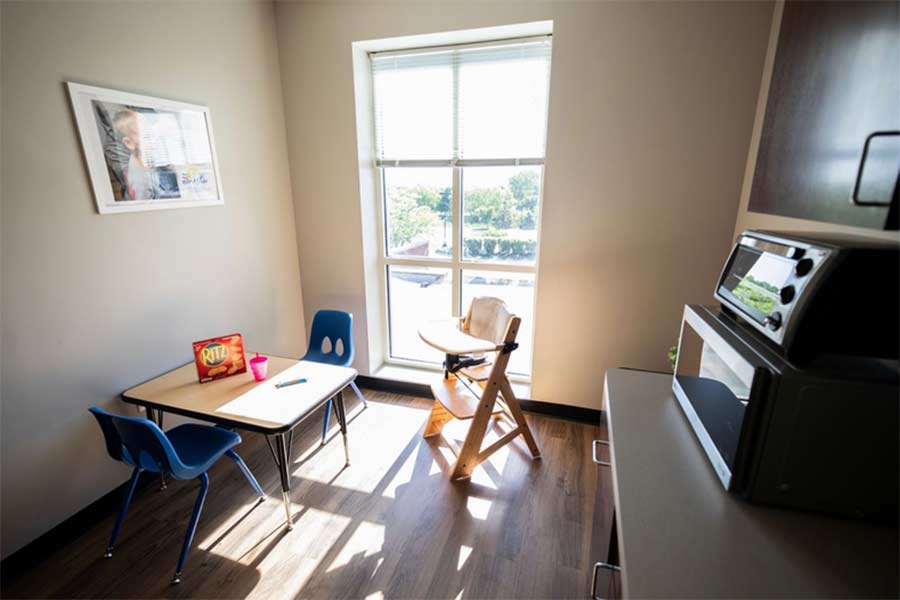Feeding therapy is conducted by a specially trained speech-language pathologist and/or occupational therapist with the goal to reduce mealtime aversions and increase overall food repertoires for proper nutritional intake. It typically is for “problem eaters” between 18 months and 18 years of age. Therapy or follow-up visits may be recommended with a frequency determined by the child’s needs.
How is it diagnosed/How do I know if my kid is a picky eater?
Based on history provided by the parent either the physician or the therapist, an evaluation aligned with treatment or simply an evaluation will be conducted to fully assess all concerns expressed. The evaluation serves to fully assess all areas of need and determine the severity of the feeding disorder present and recommendations for on-going treatment.

Most of our guidelines during assessment include:
- How restricted the range or variety of food items is; do they consume over 30 food items or less?
- Is the child “burning out” on food items by consistently eating that item and then removing it from their repertoire and not reintroducing it within a 14 day time period?
- Are they able to sit with their family and tolerate other people eating around them or are they too overwhelmed to participate in mealtimes?
- Do they express anxiety of non preferred or new food items when presented?
- Do they consume food items for each nutritional category to sustain proper nutritional intake based on their age?
What can be the cause of my child being a picky eater?
- Not introducing food items within an age appropriate time frame.
- Presenting foods that are not within age appropriate milestones.
- Force feeding.
- Feeding disorders at birth.
- Intubation at birth.
- Underlying sensory processing concerns and/or disorders.
- Other comorbidities that may be present can cause feeding disorders.
What are early signs/red flags that my child might need Feeding Therapy?
- Disinterest in food
- Regression of preferred food items
- Inability to engage or interact with food items
- Weight loss and/or poor weight gain
- Coughing/gagging/choking during feeding times
- Pocketing/storing foods in cheeks
- Less than 30 foods in their repertoire (1-4 years)
How does Westside/therapy help?
At Westside, our main goal during feeding therapy is to target increased oral feeds. This also includes reducing sensory aversions, increasing overall food repertoire, reducing food and oral aversions, increasing utensils use and increasing oral motor skills needed to consume food items. All of these are required to be a successful eater with proper nutritional intake for overall growth and development.
What does treatment look like? What are the benefits of starting therapy right away?
Please note that part of your treatment session will include: preparation of food items and table, sensory play, any oral motor exercises that may be required, presentation of items and clean-up.
- Your child will come in and may engage in sensory related activities approximately 5-10 minutes to aid in reducing sensory aversions during the session(e.g. play in rice, blowing bubbles, jumping, etc…).
- Once completed, your child and therapist will begin set-up.
- Wash hands.
- Set the table together/Prepare food items.
- The therapist and child will explore food items and the therapist will promote exploration and tolerance of items.
- Foods are presented in a very specific sequence/hierarchy by only changing shape, color, texture or food group in order to reduce sensory overload, disengagement or frustrations during each session.
- Example food hierarchy: Green veggie stick-orange veggie stick-carrot stick-hummus for dipping–sweet potato french fry-chicken fry-grilled chicken (possibly with a dip)-cauliflower-broccoli-green apple-nutella for dipping.
- Clean-up. Both the therapist and child will kiss all foods good-bye, throw them in the garbage and wipe down the table along with any additional clean-up activities.
- Your child will be sent home with a list of all food items presented throughout the session and homework to work on at home to help with carryover.
- Our therapists work very hard to tailor all programs to meet your child’s specific needs, if you ever have any questions, comments or concerns please consult your therapist.
At Home Tips For Your Picky Eater
- Have fun with food! Getting messy is an important part of your child’s development. Touch is the best way for kids to learn about their environment. Allow your child to explore textures as he/she feels comfortable. Present food in new and exciting ways: a bagel pizza with a face out of pepperoni, a shake made with yogurt, or different kinds of dipping sauces (kids love to dip!) this can be a turning point for some kids.
- Jell-o Finger Paint
- Nutty Butter Play Dough
- Stay positive! Use praise and cheers. Praise any positive behavior (i.e. “I like how you took a bite of that new food.” or “Good job touching your peas.”) and avoid constantly telling them to eat or other negative comments. We want eating to be a positive experience and not a battleground over food!
- Avoid distractions during the meals. No TV, animals, or toys should be at the table or within viewing distance. Have only food related items in front of the child.
- Expose your kids to a variety of different foods. At every snack or meal, offer at least one protein, one starch, one fruit or vegetable.
- Reduce snacking in between mealtimes or snack times and provide only water. Do NOT allow your child to “graze” or eat whenever they want throughout the day. Kids can easily fill up on these drinks between meals so try offering water between meals and milk or juice with or even after a meal.
- Offer one particular food only every other day and don’t be a short-order cook – BUT..ALWAYS present a preferred food item.. Encourage them to stay at the table during the mealtime, even if they choose not to eat. Rotate foods so the child does not have the same food everyday. Make a list of the foods your child likes and rotate them to prevent “burn out”.
- Find a mealtime routine that works for you and your family and stick with it. Be consistent and have a routine. Children rely on routine to feel safe and comfortable. When mealtimes are hard for children, setting the expectations is essential in helping them be successful when eating.
- Social modeling – Set a good example and sit down and eat with the child. Even having an older sibling who is eating the same thing can make a world of difference.
- Don’t offer too much at one time – We don’t want to overwhelm the child! Use a small plate, offer 3 foods at a time, and keep the food volume age appropriate.
- Let your child help plan and prepare meals – Children love to feel like they are contributing and preparation builds an appetite and teaches responsibility.
- Force feeding or asking a child to eat,taste or try a food they don’t want can create super-cautious or resistant behaviors that often get worse over time.It’s your child’s body, give them control over it. Letting children explore food on their own terms leads to better eating (and happier mealtimes).







